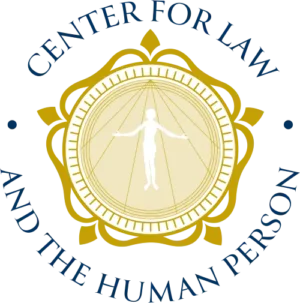People often notice our distinctive logo and ask questions about it. Many assume the person depicted in its center is Leonardo da Vinci’s “Vitruvian Man,” an image in which the human person is depicted as the model and measure of the cosmos. But, in fact, our inspiration is a different one: the Universal Man of St. Hildegard of Bingen, in which man, the pinnacle of God’s creation, is depicted as embedded within the order of the cosmos.
St. Hildegard was an 11th Century Benedictine Abbess, a visionary mystic, a theologian, and a composer of sacred music. A remarkable polymath, her writings encompassed topics such as theology, medicine, linguistics, music, and the natural sciences. Named a Doctor of the Church in 2012 by Pope Benedict XVI, he described her as possessing “rare human gifts, keen intelligence and an ability to penetrate heavenly realities.” Her visions, reflections, and illustrations, in works such as Scivias and Liber Divinorum Operum,emphasize the human person’s place within the cosmic order, where men and women, through faith and reason, together participate in God’s creative work and strive for virtue and holiness in communion with Him. St. Hildegard of Bingen’s anthropology, as explained by the Holy Father, centers on the human person as both a reflection of God’s eternal light and as destined toward eternal union with the Creator.
Today we commemorate St. Hildegard’s feast day, and so it seems like a fitting occasion to explain the features of our logo, first unveiled during our 2nd Spring Symposium in March 2023.
Just as St. Hildegard’s visions depicted the human figure within a divine and harmonious cosmos, our logo is the visual embodiment of our commitment to rightly ordered law that fosters the genuine flourishing of the human person. Law, in our view, must always serve to recognize and protect the human person, properly understood, countering the dual modern tendencies to either reduce the human person to a mere economic or utilitarian unit or to elevate the human person as an unfettered autonomous agent of his own creation.
The Human Person
The human figure, St. Hildegard’s Universal Man, is the pinnacle of God’s creation and made in His image. St. Hildegard’s man is not depicted as autonomous and self-sovereign; rather, the human person is part of creation, embedded in a network of relations, drawn to the common good, and governed by God’s Providence.
The Golden Rays of Light
Man receives the gold rays of God’s light and participates through the natural law in God’s eternal reason. That divine light, emanating from the Father and radiating through Christ and the Holy Spirit, illumines man’s path to virtue and ultimately beatitude with God.
The Tudor Rose Medallion
The design is set within the shape of the Tudor Rose medallion that was appended to the gold Collar of Esses worn by St. Thomas More, the patron saint of lawyers, in the service of King Henry VIII, as depicted in Hans Holbein’s portrait.
The Inscription
The inscription rendered in blue font surrounding the design echoes the blue in the shield of the Catholic University of America and confirms that the Center is fully aligned with the mission of the University and the Columbus School of Law.
We invite you to join us as we explore this vision of law and the human person and may St. Hildegard intercede for all of us.


